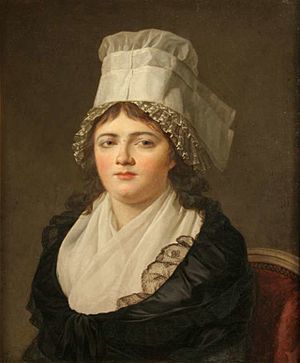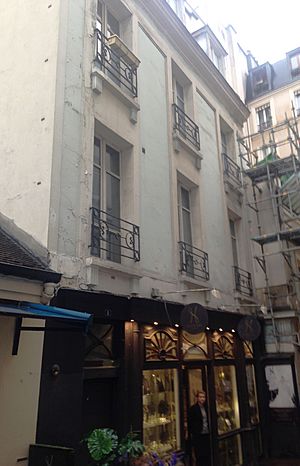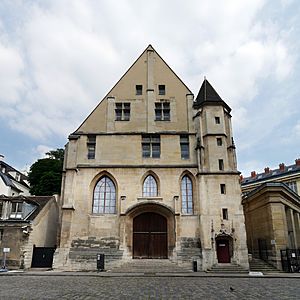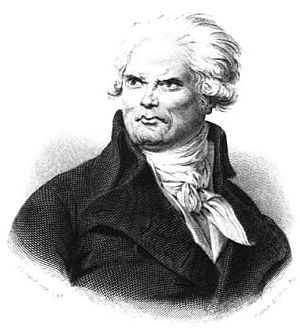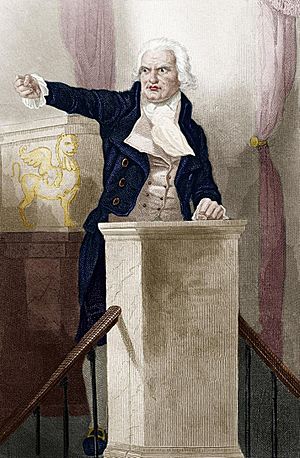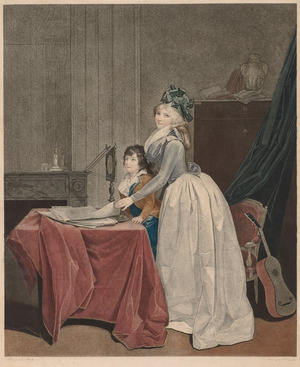Georges Danton facts for kids
Quick facts for kids
Georges Danton
|
|
|---|---|
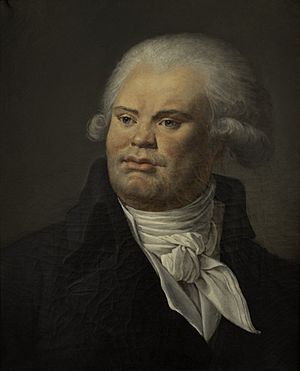
Georges-Jacques Danton. Musée Carnavalet, Paris
|
|
| Member of the Committee of Public Safety | |
| In office 6 April 1793 – 10 July 1793 |
|
| Preceded by | Office created |
| Minister of Justice | |
| In office 10 August 1792 – 9 October 1792 |
|
| Preceded by | Étienne Dejoly |
| Succeeded by | Dominique Joseph Garat |
| 23rd President of the National Convention | |
| In office 25 July 1793 – 8 August 1793 |
|
| Preceded by | Jean Bon Saint-André |
| Succeeded by | Marie-Jean Hérault de Séchelles |
| Deputy in the National Convention | |
| In office 20 September 1792 – 5 April 1794 |
|
| Constituency | Seine |
| Personal details | |
| Born | 26 October 1759 Arcis-sur-Aube, Kingdom of France |
| Died | 5 April 1794 (aged 34) Paris, First French Republic |
| Cause of death | Execution by guillotine |
| Political party | The Mountain (1792–1794) |
| Other political affiliations |
Cordeliers Club (1790–1791) Jacobin Club (1791–1794) |
| Spouses |
Antoinette Gabrielle Charpentier
(m. 1787; Louise Sébastienne Gély
(m. 1793) |
| Children | 3 |
| Parents | Jacques Danton Mary Camus |
| Occupation | Lawyer, politician |
| Signature | |
Georges Jacques Danton (French: [ʒɔʁʒ dɑ̃tɔ̃]; 26 October 1759 – 5 April 1794) was a key figure in the early stages of the French Revolution. Known for his fiery speeches, Danton played a significant role in the overthrow of the French monarchy and the establishment of the First French Republic. However, his moderate stance during the Reign of Terror led to his downfall and execution by guillotine in 1794.
Contents
Early life
Danton was born in Arcis-sur-Aube (Champagne in northeastern France) to Jacques Danton, a respectable, but not wealthy lawyer, and Mary Camus. He initially attended the school in Sézanne, and at the age of thirteen he left his parents' home to enter the seminary in Troyes.
In 1780, he settled in Paris, where he worked as a lawyer and became involved in revolutionary activities, joining the Cordeliers Club, a radical political group.
Revolution
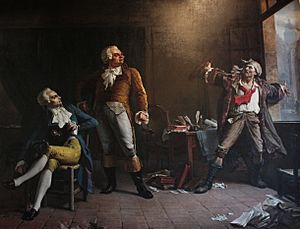
Danton became a very important leader during the revolution. He was a powerful speaker, and he used his words to inspire people to fight for their rights. He helped create the revolutionary government and worked to improve the lives of ordinary people. He helped establish new laws and systems to make France fairer.
He was also involved in the creation of the revolutionary tribunals, which were courts that tried people accused of opposing the revolution.
Reign of Terror
A period called the "Reign of Terror" followed. During this time, many people were executed because they were seen as enemies of the revolution. Danton, while initially a supporter of strong action, later became concerned about the level of violence. He believed that the revolution needed to calm down and focus on building a better future.
Ultimately, Danton himself would become a victim of the Terror. In attempting to shift the direction of the revolution by collaborating with Camille Desmoulins on the production of Le Vieux Cordelier—a newspaper that called for the end of the official Terror and Dechristianization, as well as for launching new peace overtures to France's enemies—Danton had placed himself in a precarious position. Those most closely associated with the Committee of Public Safety, among them key figures such as Maximilien Robespierre and Georges Couthon, would eventually indict Danton for counter-revolutionary activities.
Financial corruption and accusations
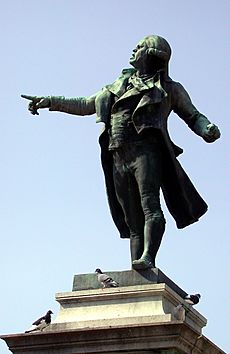
Toward the end of the Reign of Terror, Danton was accused of various financial misdeeds, as well as using his position within the Revolution for personal gain. Many of his contemporaries commented on Danton's financial success during the Revolution, certain acquisitions of money that he could not adequately explain. Many of the specific accusations directed against him were based on insubstantial or ambiguous evidence. For the Revolutionary Tribunal legal evidence was unnecessary, moral conviction by jury was enough to speed up the proceedings.
Arrest, trial, and execution
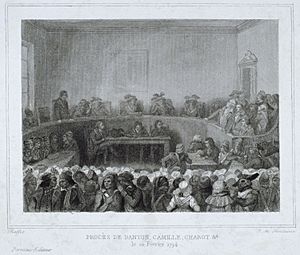
On 30 March, Danton was arrested and put on trial. Despite his eloquence during the trial, he was found guilty and sentenced to death. On April 5, 1794, he was executed by guillotine along with a group of fifteen people that included Marie Jean Hérault de Séchelles, Philippe Fabre d'Églantine and Pierre Philippeaux among others.
Personal life
In 1784, he started studying law, and in 1787 he became a member of the Conseil du Roi. He married Antoinette Gabrielle Charpentier (c. 1762 – 10 February 1793) on 14 June 1787 at the church of Saint-Germain-l'Auxerrois. The couple lived in a six-room apartment in the heart of the Left Bank (near the Café Procope), and had three sons:
- François, born in May 1788, died in infancy on 24 April 1789.
- Antoine, born on 18 June 1790, died on 14 June 1858.
- François Georges, born on 2 February 1792, died on 18 June 1848.
On 10 February 1793, while Danton was on a mission in Belgium, his wife died while giving birth to their fourth child, who also died.
On 1 July 1793, Danton married Louise Sébastienne Gély, aged 16, daughter of Marc-Antoine Gély, court usher (huissier-audiencier) at the Parlement de Paris and member of the Club des Cordeliers.
Interesting facts about Georges Danton
- Danton was attacked by a bull and run over by pigs in his childhood, which, along with smallpox, resulted in the disfigurement and scarring of his face.
- As a pupil, Danton once spoke out against corporal punishment in class. His speech was so persuasive that the head of the school decided to ban the practice.
- His last words, spoken to his executioner were to ''show the people my head. It is well worth seeing.''
Georges Danton quotes
- "After bread, education is the first need of the people."
- "Audacity, and again, audacity, and always audacity."
- "One must never compromise with tyrants. "
- "Let us be terrible in order to prevent the people from being terrible themselves!"
Fictionalized accounts
- Danton, Robespierre, and Marat are characters in Victor Hugo's novel Ninety-Three (Quatrevingt-treize), set during the French Revolution.
- Danton is a central character in Romanian playwright Camil Petrescu's play of the same name.
- Danton's last days were made into a play, Dantons Tod (Danton's Death), by Georg Büchner.
- On the basis of Büchner's play, Gottfried von Einem wrote an opera with the same title, on a libretto by himself and Boris Blacher, which premiered on 6 August 1947 at the Salzburger Festspiele.
- Danton appears in the Hungarian play The Tragedy of Man and the animated movie of the same name as one of Adam's incarnations throughout Lucifer's illusion.
- Danton's life from 1791 until his execution was the subject of the 1921 German film Danton.
- Danton's and Robespierre's quarrels were turned into a 1983 film, Danton, directed by Andrzej Wajda. The film itself is loosely based on Stanisława Przybyszewska's 1929 play Sprawa Dantona ("The Danton Case").
- Danton's and Robespierre's relations were also the subject of an opera by American composer John Eaton, Danton and Robespierre (1978).
- Danton is extensively featured in La Révolution française (1989),.
- In his novel Locus Solus, Raymond Roussel tells a story in which Danton makes an arrangement with his executioner for his head to be smuggled into his friend's possession after his execution. The nerves and musculature of the head ultimately end up on display in the private collection of Martial Canterel, reanimated by special electrical currents and showing a deeply entrenched disposition toward oratory.
- The Revolution as experienced by Danton, Robespierre, and Desmoulins is the central focus of Hilary Mantel's novel A Place of Greater Safety (1993).
- Danton and Desmoulins are the main characters of Tanith Lee's The Gods Are Thirsty—A Novel of the French Revolution (1996).
- Danton and Robespierre are briefly referred to in the book The Scarlet Pimpernel. The two men both applaud a guard for his work in catching aristocrats.
- In The Tangled Thread, Volume 10 of The Morland Dynasty, a series of historical novels by author Cynthia Harrod-Eagles, the character Henri-Marie Fitzjames Stuart, bastard offshoot of the fictional Morland family, allies himself with Danton in an attempt to protect his family as the storm clouds of revolution gather over France.
- Danton appears briefly in Rafael Sabatini's adventure novel Scaramouche: A tale of romance in the French Revolution.
- Danton appears in a series of comics entitled "The Last Days of Georges Danton" in Step Aside, Pops: A Hark! A Vagrant Collection by Kate Beaton.
- Danton is one of six point-of-view characters in Marge Piercy's novel City of Darkness, City of Light (1996).
- Danton, along with Marat and Robespierre, is a secondary character in the 1927 epic Napoléon. His portrayal in the film is somewhat cartoonish, as he is depicted as a decadent fop, albeit dedicated to republicanism and revolution, and it is he that allows Rouget de Lisle to premiere "La Marseillaise" at the Club des Cordeliers. (In reality, no such performance by Rouget de Lisle is known to have taken place.)
See also
 In Spanish: Georges-Jacques Danton para niños
In Spanish: Georges-Jacques Danton para niños


